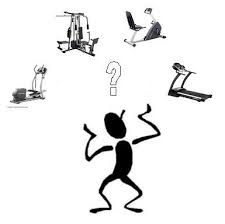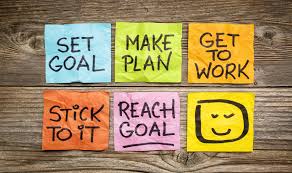When you want to get started on an exercise program, how do you know where to start?
That’s the basic question, and most would-be exercisers get it wrong. While they might have a vague idea of where they’d like to end up, they don’t really know how to get there. And sometimes they don’t even know where they want to be. Then they start, stop, start again, get discouraged, and quit.
Today I’ll take you through the general plan you want to use when designing an exercise program. And I’m going to use the most basic of goals and exercises to give you an idea of where to start, where to aim, and how you can modify your program to suit your needs.

Determine your goal—
Do the first things first: ask yourself what you want to accomplish. It could be gaining muscle, losing belly fat, or wanting to run or walk a 5K race. Anything. Just make sure you have a good (honest) idea of where you’re starting from. If you’ve never walked or run a 5K, you won’t start your exercise program by charging out on daily 5K walks around your neighborhood. You’ll start with your baseline—the level of fitness you are today, at this time. Not what you wish you were. And then plan your progress from there.
Case Study—
I’ll use myself as an example.
It seemed to happen quickly, although it really occurred over the course of six months to a year. I’d been ignoring my exercise program, spending way too much time sitting in a chair in front of my computer writing stories and articles. I’d even given up my nightly calisthenics and walks with my Shetland sheepdog Dolly. (I wish she’d said something to me, although I should have gotten a clue from her plaintive looks.)
Anyway, one day I saw pictures the engineer took of the family, and I nearly gagged. (Actually, I did gag, before I got mad.) There in the picture, staring back at me were my face and chest, but someone else’s arms were attached to my body. Just when did my upper arms go from toned to fat? And when did they acquire that excess skin hanging under them?!
Yee, gads! Without my noticing, my arms had become old and flappy! Clearly I was no longer the toned athlete I once was and still envisioned myself to be. I took a hard look at myself in the bathroom mirror and raised my arm. It waved at me. Ugh! I thought I’d get physically sick in the sink. Instead, I got mad and decided I’d get even. And getting even meant doing some area-specific exercises to get those puppies back in shape!
Plan and process—
To get my arms back in shape, I had several options. I could get myself back in the gym and do some arm-specific machine weights or dumbbell lifting. Or I could pick up the dumbbells I have at home more often and use them. Or go back to doing my pushups every night before bed.
I decided on all three, but today I’m just going to show you how I use the pushups to get my arms under control.
Why pushups? Because they’re the easiest, most basic exercise you can do, at home, at your convenience, with no financial expense. And they can be done at pretty much any age, although you might have to modify the position slightly for your age and strength. There’s a reason pushups have been a staple in physical education classes for eons. They work!

So how would I start?
First, I wanted to increase my strength a little, so I set out the first night to do one set (yes, just one) of pushups. Because both wrists were damaged during my gymnastics career, I have to do bent knee style pushups. My wrists can’t take a full body load.
Since I was aiming to increase my strength, I did enough pushups to take me to the state of exhaustion, where I couldn’t lower and raise my body. One. More. Time. And that was it. Just one set. To exhaustion. For me, that ended up being around 35 pushups. All-the-way-down and all-the-way-up pushups. Not half-down types, or swayback with tummy touching the ground first technique. Real pushups.
And I tend to slow down when I lower myself to the ground and speed up when I’m returning to the starting position. Why? Because that’s a more optimal way to gain strength and increase muscle size with this particular exercise. It’s called negative (eccentric) loading. But that’s beyond the scope of today’s post. We’ll cover that in a future post.
And then I stand and stretch out my chest and arms. You ALWAYS want to stretch to keep your muscles as healthy and responsive as possible.
The following evening I repeated the pushups, to exhaustion. I ended up making it to the same level, about 35. If I find myself being able to do a lot more, then either something was wrong the night before, or I didn’t really work to exhaustion the first night.
Every night I continue like this. I don’t set a number to achieve, although I do make sure I don’t increase my number more than 10% of the number achieved the night before. (Exercise rule.) If I can do a couple more, I’ll do more. But what usually happens is that it takes at least a week for my body to build up to a comfortable 35, where I notice that it no longer feels like burning, I-just-can’t-pump-out-another-one exhaustion.
After several (3) weeks, I should be up to 40. And I can keep going like this for months, increasing the number of pushups.
Modifying your program to meet your needs—
But I have a body issue to consider. My muscle makeup is not average, or normal. I don’t have 50% red, long distance, marathon-type muscles and 50% white, speedy-type muscles. My body is made up mostly of speedy type muscle fibers, which means I can gain muscle strength and size (bulk up) really quickly. And that’s not what my ultimate goal is for my arms.
I want them lean and contoured. Toned. So what now?
I switch my program up. I’ll still use the pushups, but now I’ll perform them a different way.
The first night I’ll do 12 pushups and then rest for 30 seconds. Then I’ll do 12 more pushups and rest for 30 seconds. And I might do them faster, the same speed up as down. I’ll do at least three sets like this, maybe more. A lot more. This way I’m focusing more on tone, the endurance type of muscles that will give my arms a more toned appearance. And in the process, my chest tightens up and lifts those breast muscles so they look a little perkier! Pushups are A+ exercises for chest muscles. (Not a bad payoff!)
That way I can whittle away at the fat, and slim the muscle down to a nice shape. Like a sculptor chiseling away at a hunk of marble or clay.
You can apply this same principle to your legs to strengthen and tone your thighs and outer thighs and calves.
You just need to know what your ultimate goal is and then figure out the steps to get there!
NEXT WEEK: We’ll look at walking and how to plan your workout for that activity.
Until then,
Happy pushupping!
Blessings,
Andrea
May you prosper in all things and be in health, just as your soul prospers (3 John 2).
Photos provided by Google Images







